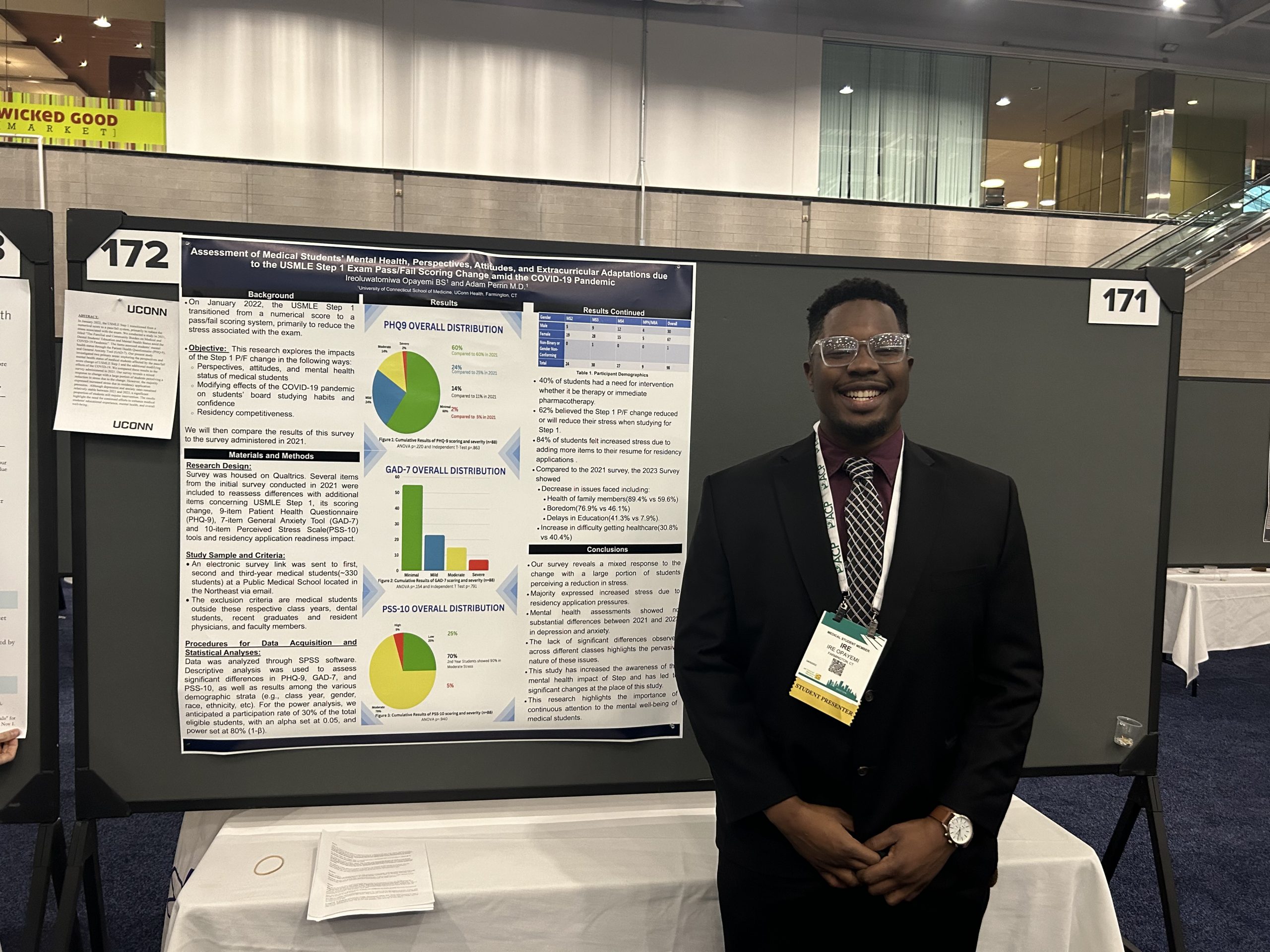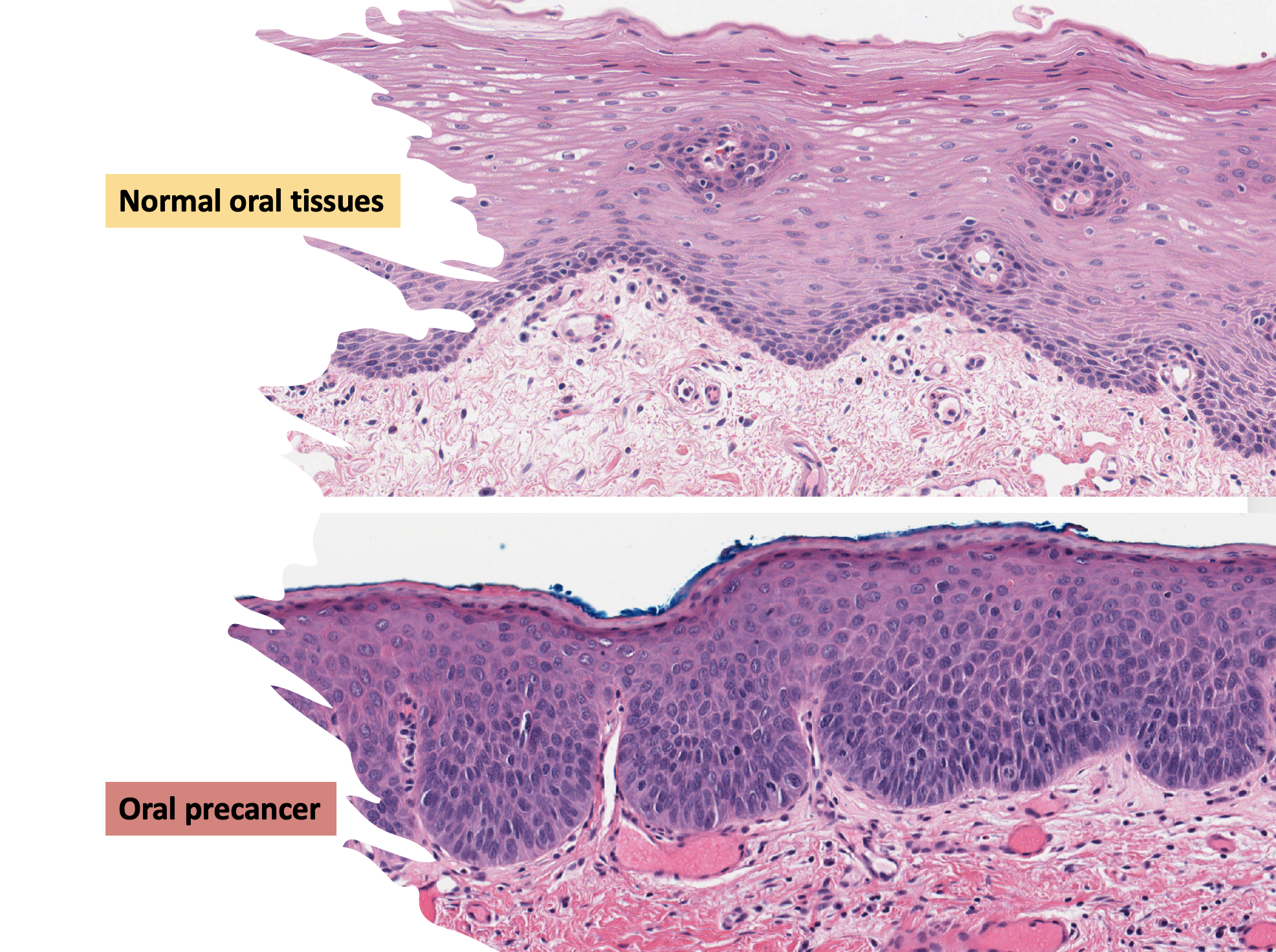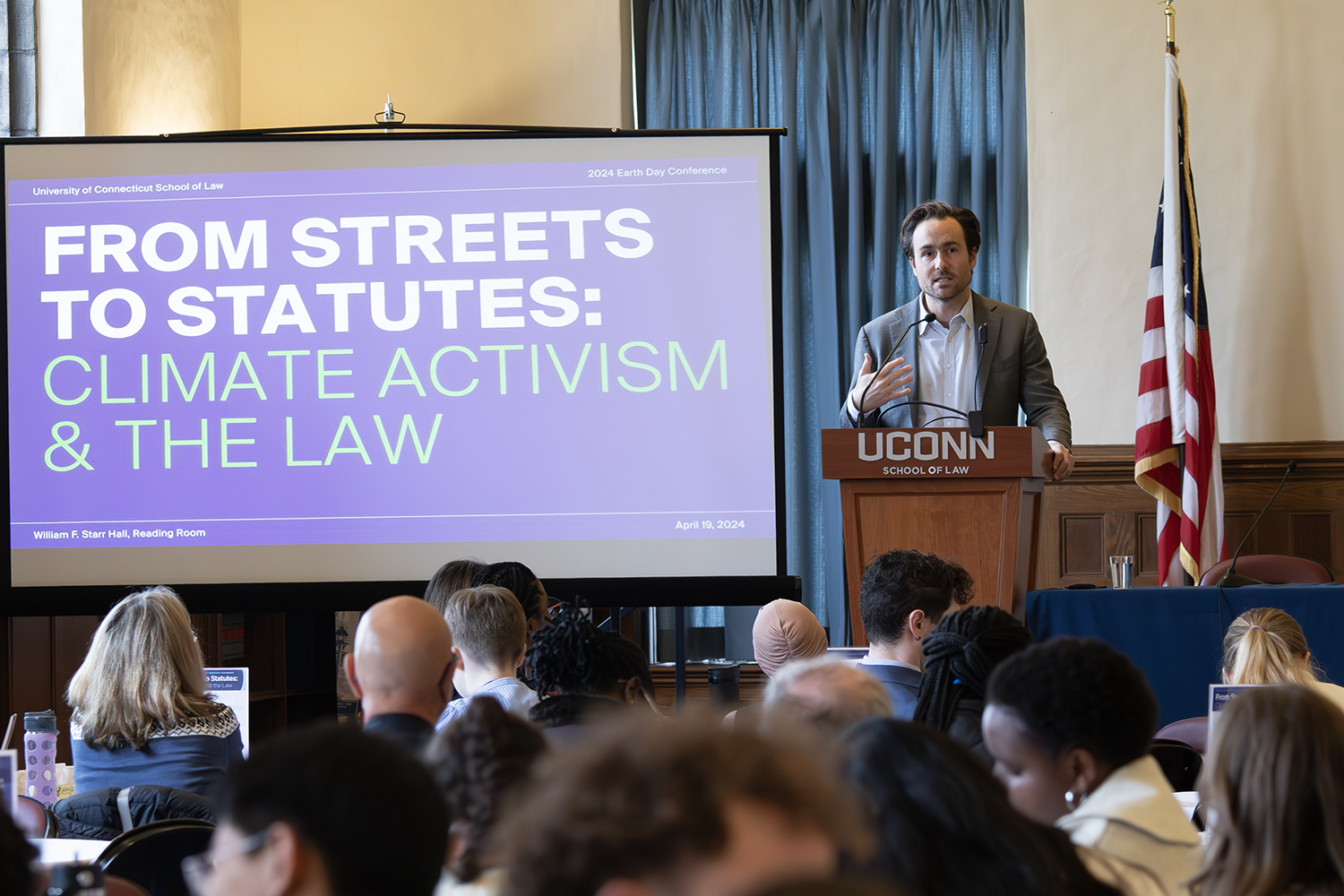A scoop of Salted Caramel Crunch and a scoop of Toasted Almond Amaretto nestle together in a cup. If you can, let it sit for five minutes so the ice cream just begins to melt, creating a little pool in the bottom of the cup. (In July, this step is not required.) Now, spoon a small amount from each sphere, saucing it with some of the liquid from the bottom of the cup.
Oh. My. Goodness.
This mini-miracle must be the result of some sort of wizardry: Milk from the cows on Horsebarn Hill goes into the shiny steel vats of the UConn Creamery. A spell is cast, and poof! The best ice cream in the world appears. But there’s no magic here; what makes this sublime treat is passion, hard work and scrupulous attention to detail—along with the best ingredients you can get.
UConn’s ice cream begins with the milking cows in the Kellogg Dairy Center (KDC) on Horsebarn Hill, just about 700 yards from the Dairy Bar. (The cows you see grazing on the hill are their not-yet-bred daughters, called heifers.) The UConn Department of Animal Science’s dairy herd is a mix of Holsteins and Jerseys, and a remarkable group of dams it is. The herd has just been ranked by the venerable Hoard’s Dairyman as one of the top twenty of approximately 47,000 dairy herds in the country, receiving a gold ”Best of the Best” National Dairy Quality Award. This accomplishment, extraordinary in itself, is made all the more so by the fact that many of those who tend to the cows are students studying dairy management and milk production in an experiential learning environment. Only one other university herd, from the University of Wisconsin, made the Hoard’s list. The list recognizes milk quality, the primary measure of which is the milk’s somatic cell count (SCC). The lower the number of somatic cells in the milk, the better the animals’ health and the longer the shelf life and finer the quality of the dairy products made from it. This starts to explain why the ice cream’s so good.
UConn has a long and distinguished history in dairy science, with significant contributions in the areas of animal health and production efficiency. In 1901, Herbert William Conn, formerly of Wesleyan University, Trinity College and Cold Spring Biological Laboratory (now Cold Spring Harbor Laboratory), came as a lecturer to what was then Connecticut Agricultural College and established the bacteriology program. In 1905, Conn was appointed Connecticut State Bacteriologist, helping organize and direct the State Bacteriological Laboratory, and in 1911, he was appointed to the National Commission on Milk Standards. He was a founding member of the American Society for Microbiology.
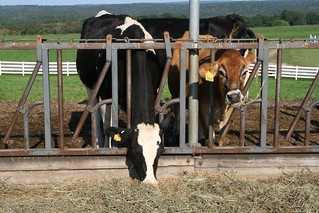 In 1919, George C. White, for whom the building that houses the Department of Animal Science is named, served as president of the American Dairy Science Association. In the 1940s, E.O. Anderson studied the action of penicillin against mastitis, inflammation of the udder tissue, in milk. In the 1950s and 60s, B.W. Pickett and other department faculty contributed to the emerging technology of freezing semen, developing a method for sealing plastic straws of semen and a gun for insemination. In the 1970s, C.O. Woody and his colleagues worked in the area of estrus control, refining an ear implant that delivered hormones to regulate the reproductive cycle. In the 1970s, Lynn Brown worked with Frito-Lay to incorporate potato material from the manufacturing of potato chips into dairy cattle feed. And, in 1999, Jerry Yang’s research produced Amy, a Holstein calf that was the first cloned farm animal in the United States, and the first farm animal in the world cloned with non-reproductive cells.
In 1919, George C. White, for whom the building that houses the Department of Animal Science is named, served as president of the American Dairy Science Association. In the 1940s, E.O. Anderson studied the action of penicillin against mastitis, inflammation of the udder tissue, in milk. In the 1950s and 60s, B.W. Pickett and other department faculty contributed to the emerging technology of freezing semen, developing a method for sealing plastic straws of semen and a gun for insemination. In the 1970s, C.O. Woody and his colleagues worked in the area of estrus control, refining an ear implant that delivered hormones to regulate the reproductive cycle. In the 1970s, Lynn Brown worked with Frito-Lay to incorporate potato material from the manufacturing of potato chips into dairy cattle feed. And, in 1999, Jerry Yang’s research produced Amy, a Holstein calf that was the first cloned farm animal in the United States, and the first farm animal in the world cloned with non-reproductive cells.
Currently, Associate Professor Kristen Govoni and her postdoctoral fellow, Maria Hoffman, are studying how maternal milk production affects male offspring birth weight and circulating growth factors, metabolites and immunology. Findings will be used to develop management and intervention strategies to improve calf growth and health.
Mary Margaret Cole, executive program director in the Department of Animal Science, is responsible for the dairy herd, and indeed all the other livestock operations with the exception of the horses. In managing the herd, says Cole, the health of the cows and the cleanliness of the milking system are her paramount concerns. She continues, “Cow comfort is the number one priority. It has to be. And for them to make as much milk as possible but be healthy while doing so.”
The KDC’s stalls are bedded with mattresses and groomed three times daily to keep them clean, airy and dry. There’s plenty of water; lactating cows drink a lot of water, and it must be clean. Feed is always available in the barn’s feed bunk. Total Mixed Ration, or TMR, is mixed onsite and consists of UConn-produced corn silage; corn meal, canola meal, sodium bicarbonate, alfalfa hay and rumen bypass fat (which helps the cows keep weight on during peak lactation) along with a custom blend of additional protein, vitamins and minerals. Lactating Jersey cows eat approximately ninety pounds per day, Holsteins about 120 pounds.
 Under Cole’s supervision, four to five staff members and eight students tend to the herd. Four of the students, all animal science or pathobiology and veterinary science majors, live in dorm-style rooms at the KDC. In caring for the cattle, the students apply hands-on what they have learned in the classroom. The rigorous curriculum for a major in animal science requires courses in biology, microbiology, chemistry, animal nutrition and feeding, animal genetics, anatomy and physiology, and reproductive physiology. The minor in dairy management requires additional courses in dairy cattle management, dairy management decision-making, food microbiology, business finance and management, and health and disease management.
Under Cole’s supervision, four to five staff members and eight students tend to the herd. Four of the students, all animal science or pathobiology and veterinary science majors, live in dorm-style rooms at the KDC. In caring for the cattle, the students apply hands-on what they have learned in the classroom. The rigorous curriculum for a major in animal science requires courses in biology, microbiology, chemistry, animal nutrition and feeding, animal genetics, anatomy and physiology, and reproductive physiology. The minor in dairy management requires additional courses in dairy cattle management, dairy management decision-making, food microbiology, business finance and management, and health and disease management.
Says Cole, an alumna of the program, “It’s nice for the students to see what they learned in the classroom come to life and to watch their eyes light up when they see a calf born for the first time. I’ve seen thousands of calves born, and it never gets old.”
Cole spends many hours training new student hires. “I have a great group of kids. We have written established protocols, and they train with full-time staff. The students get a lot of hands-on experience. They learn to give injections, how and why we vaccinate, how to do CMT tests for mastitis, how to take a cow’s temperature. They learn why cleanliness is so important. They have a little freedom here at night, and it sharpens their diagnostic skills. They know what they should do, but they often call me. Sometimes two or three calls a night, sometimes I get a couple of full nights’ sleep.” Cole would not have it any other way.
So how is this marvelous milk made into exquisite ice cream?
The UConn Creamery, which is operated by the Department of Animal Science, has been processing milk since the early 1900s. Since the 1950s, its UConn Dairy Bar ice cream has received countless accolades—Best of Connecticut from Connecticut Magazine, Best of New England from Yankee Magazine, rave reviews from the Boston Globe, BusinessInsider.com and Spoonuniversity.com, and on and on.
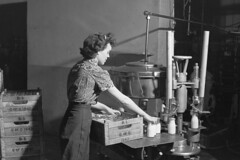 Two to three times a week Bill Sciturro, manager of the creamery and its ice cream maker since 2007, picks up milk, 175 gallons at a time, from the Kellogg Dairy Center. Sciturro left a career in rehab counseling to follow his passion for making ice cream. “It’s a happy business!” he says.
Two to three times a week Bill Sciturro, manager of the creamery and its ice cream maker since 2007, picks up milk, 175 gallons at a time, from the Kellogg Dairy Center. Sciturro left a career in rehab counseling to follow his passion for making ice cream. “It’s a happy business!” he says.
Only UConn milk is used in the ice cream; it’s the first ingredient on the label. The creamery uses about 25 percent of the milk produced up the hill, and the rest is sold to the dairy cooperative Agrimark. Although sold as a commodity, the milk earns a premium for its high quality.
“We have twenty regular flavors and seasonal specials,” says Sciturro, “Each of the regular flavors has survived dozens of short-term replacements. To make a new flavor, we have to take off someone’s favorite. Every regular flavor has its loyal following.” The three most popular flavors are vanilla, chocolate and Husky Tracks, vanilla ice cream swirled with fudge and embellished with chunks of Reese’s Peanut Butter Cups.
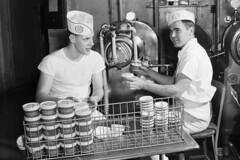 It takes about twenty-two hours over a two-day period to make a batch of UConn Dairy Bar ice cream. The first half of the process is the production and pasteurization production of the base mix. The second day turns the mix into ice cream. A 350-gallon batch of mix makes on average about 650 gallons of ice cream, depending on the bulk of the additional ingredients.
It takes about twenty-two hours over a two-day period to make a batch of UConn Dairy Bar ice cream. The first half of the process is the production and pasteurization production of the base mix. The second day turns the mix into ice cream. A 350-gallon batch of mix makes on average about 650 gallons of ice cream, depending on the bulk of the additional ingredients.
Most small-batch ice cream producers buy pre-made mix. The UConn Creamery makes its own, and if there is any magic in the process, it’s in making the mix that it happens. The ice cream’s complex, deep flavor is a result of the low-temperature, long-time hold (LTLT) pasteurization process that caramelizes the sugars in the mix. UConn’s mix is heated to above 160 degrees and held for thirty minutes. The resulting flavor cannot be duplicated with the high-temperature, short-hold process used for mass-produced ice cream, in which the mix is heated to as much as 180 degrees and held for as little as fifteen seconds. The LTLT process is expensive and the long hold cuts into production efficiency, but the results are worth it. Says Sciturro, “We don’t cut any corners. We use the very best possible ingredients and we use what is universally acknowledged to be the best process.”
Students are involved in producing the ice cream as well as the milk. About ten students are employed by the creamery at any given time, with two or three on each shift. To meet the ever-growing demand for UConn ice cream, Sciturro recently added a second shift; the shop now operates eleven hours a day, five days a week. The creamery made 49,882 gallons of ice cream in 2016, up from 14,406 gallons in 2004.
Sciturro runs a tight ship with a constant focus on quality, sanitation, aggressive preventive equipment maintenance and sourcing the highest-quality ingredients available. Each day begins with spotlessly clean equipment and facilities; a batch of perfect ice cream is made, poured and frozen; and the day ends with spotlessly clean equipment and facilities. “People who work in offices have a pile of projects on their desks that can be pushed to tomorrow. We can’t work that way. At the end of every production day, the equipment must be cleaned, prepared for the next day and ready to go. Although that quick turnaround is sometimes stressful, I’ll admit there’s something satisfying about starting and ending the day at the same place, and let’s not forget that a freezer full of ice cream is a great thing.” Sciturro says his favorite part of the whole process is watching through the creamery’s observation window as people line up for ice cream: “Nobody’s not happy when they come for ice cream.”
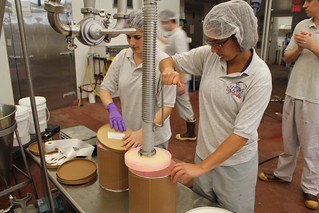 The UConn Creamery is also equipped to make cheese. Assistant Professor Dennis D’Amico came to the department in 2013 with a PhD in food microbiology and a fascination with cheese and other traditional fermented dairy foods. “I’m simply amazed by what microbes can do to something as basic as milk … But also, I really love ice cream.” When there is room in the production schedule, D’Amico and Sciturro make cheese, including their popular juustoleipa, a Finnish fresh cheese that is baked before eating, creating a toasted crust (juustoleipa means bread cheese), and queso blanco, a Mexican-style fresh cheese for which they have won medals from the American Cheese Society and the Eastern States Exposition.
The UConn Creamery is also equipped to make cheese. Assistant Professor Dennis D’Amico came to the department in 2013 with a PhD in food microbiology and a fascination with cheese and other traditional fermented dairy foods. “I’m simply amazed by what microbes can do to something as basic as milk … But also, I really love ice cream.” When there is room in the production schedule, D’Amico and Sciturro make cheese, including their popular juustoleipa, a Finnish fresh cheese that is baked before eating, creating a toasted crust (juustoleipa means bread cheese), and queso blanco, a Mexican-style fresh cheese for which they have won medals from the American Cheese Society and the Eastern States Exposition.
The Department of Animal Science has always had a core group of students interested in dairy production, or management of the cows. There is now growing student interest in dairy food manufacturing. Department head Steven Zinn attributes this in part to the ice cream and to the fact that “the department was able to hire a nationally known food scientist [D’Amico] with an interest in dairy who also does extension and research.” The department offers courses in food products, probiotics and food chemistry. Since D’Amico arrived, he has taught Animal Food Products: Dairy Technology and the associated writing course. Since 2013, twenty-one undergraduate students have completed dairy product-related independent studies. Students’ growing interest in dairy foods also comes at a time when consumers have an increasing curiosity about where their food comes from and concern about how it’s produced.
Says D’Amico, “Students get to take what they’ve learned in dairy production and farm management and see what happens to the milk next. They learn how dairy products are made and get to see firsthand why it was so important to keep the somatic cell count low, why you had to do this or that for milk quality. It brings it full circle.”
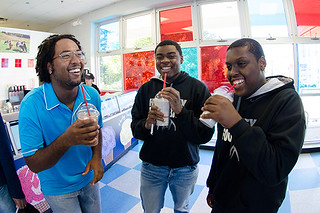 Sciturro, D’Amico and the creamery itself are vital resources for dairy manufacturing businesses in Connecticut and across the United States. Each year, Sciturro is sought out by dozens of producers, both experienced and new, from across the country for information and advice on technical issues related to ice cream production, including plant design, equipment types, business plan development and to-spec formulation. He also collaborates with other UConn programs as varied as the Institute of Materials Science (to study the microstructure of ice cream composition), a year-long engineering senior design project (to design a no-sugar-added novel ice cream product) and a tour and discussion on mass heat transfer properties of ice cream production for a chemical engineering class, to serving as a topic for a journalism class’s writing assignment. D’Amico, who was senior research scientist and lecturer at the Vermont Institute for Artisan Cheese while completing his PhD, has developed a national reputation as an expert on artisanal cheese making and frequently advises those looking to get into the business. He is currently developing an online food safety workshop for dairy foods producers that will launch later this year in partnership with North Carolina State University.
Sciturro, D’Amico and the creamery itself are vital resources for dairy manufacturing businesses in Connecticut and across the United States. Each year, Sciturro is sought out by dozens of producers, both experienced and new, from across the country for information and advice on technical issues related to ice cream production, including plant design, equipment types, business plan development and to-spec formulation. He also collaborates with other UConn programs as varied as the Institute of Materials Science (to study the microstructure of ice cream composition), a year-long engineering senior design project (to design a no-sugar-added novel ice cream product) and a tour and discussion on mass heat transfer properties of ice cream production for a chemical engineering class, to serving as a topic for a journalism class’s writing assignment. D’Amico, who was senior research scientist and lecturer at the Vermont Institute for Artisan Cheese while completing his PhD, has developed a national reputation as an expert on artisanal cheese making and frequently advises those looking to get into the business. He is currently developing an online food safety workshop for dairy foods producers that will launch later this year in partnership with North Carolina State University.
Improved efficiency in production and resulting lower milk prices paid to farmers have made it increasingly difficult to make a living from fluid milk alone, particularly in states like Connecticut where production costs such as energy and feed components are high. To help dairy farming remain economically sustainable, some producers are diversifying into the manufacture of value-added products like cheese, yogurt, butter and ice cream. Consumer demand for many of these products continues to grow, driving a demand for college graduates skilled in dairy manufacturing. A September 2015 article on ProgressiveDairy.com describes recent reinvestment in campus creameries by several universities, including UConn, to provide optimum learning environments for students. Upgrades to the UConn Creamery have included replacement and expansion of the freezer system and installation of cheese making equipment, including an industrial oven.
In addition to the recent plant improvements funded by the University, UConn has also received significant support for students in dairy production and dairy manufacturing from what some might consider a surprising source. George Malkemus and Tony Yurgaitis are top executives at Manolo Blahnick, the shoe designer made a household name by the HBO series Sex and the City. In 1999, they bought an old farm in Bantam, Connecticut, to save it from development. They christened it Arethusa Farms and, beginning with five dairy cows, they have grown their herd to a renowned breeding program that has received numerous international awards. When Arethusa Farms moved into the manufacture of dairy products, Sciturro and D’Amico provided technical assistance in their respective areas of expertise. In addition, two undergraduate students in the department have completed internships at Arethusa. In 2016, to help promote Connecticut agriculture and its dairy industry, Malkemus and Yurgaitis donated the proceeds of two shoe sales, amounting to more than $283,000, to endow the Arethusa Scholarship for students majoring in dairy production or manufacturing at UConn. Another sale is planned for August 2017. Says Zinn, “They’re good guys, passionate about they do and about helping students who might otherwise not have the wherewithal to afford college.”
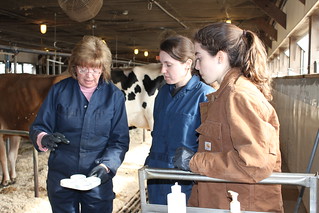 The department’s extension outreach to those interested in dairy science serves all ages. Sheila Andrew, professor of animal science and extension dairy specialist, supports the Connecticut dairy industry, working directly with farmers to address production problems, particularly those related to nutrition and mastitis, and coordinating an annual conference for dairy producers and associated agribusinesses. She administers the Eastern States 4-H dairy program, including the science-based knowledge test and 4-H Dairy Quiz Bowl. She and Mary Margaret Cole co-advise the UConn Dairy Club, which produces the popular Dairy Show each spring and for which any UConn student may learn to show a cow. Club members travel each year to the Royal Agricultural Winter Fair, the world’s largest combined indoor agricultural fair and international equestrian competition, visiting notable dairy farms along the way. During UConn’s January intersession, Andrew offers the weeklong one-credit New England Regional Dairy Travel Course, for which eight to ten students visit dairy farms, agribusinesses, state departments of agriculture and other schools of agriculture. She has served as UConn’s coach for the Dairy Challenge, a rigorous regional and national collegiate competition in which student teams evaluate a dairy farm’s finances, management, nutrition and milk quality and develop a 20-minute PowerPoint presenting their findings to the judges.
The department’s extension outreach to those interested in dairy science serves all ages. Sheila Andrew, professor of animal science and extension dairy specialist, supports the Connecticut dairy industry, working directly with farmers to address production problems, particularly those related to nutrition and mastitis, and coordinating an annual conference for dairy producers and associated agribusinesses. She administers the Eastern States 4-H dairy program, including the science-based knowledge test and 4-H Dairy Quiz Bowl. She and Mary Margaret Cole co-advise the UConn Dairy Club, which produces the popular Dairy Show each spring and for which any UConn student may learn to show a cow. Club members travel each year to the Royal Agricultural Winter Fair, the world’s largest combined indoor agricultural fair and international equestrian competition, visiting notable dairy farms along the way. During UConn’s January intersession, Andrew offers the weeklong one-credit New England Regional Dairy Travel Course, for which eight to ten students visit dairy farms, agribusinesses, state departments of agriculture and other schools of agriculture. She has served as UConn’s coach for the Dairy Challenge, a rigorous regional and national collegiate competition in which student teams evaluate a dairy farm’s finances, management, nutrition and milk quality and develop a 20-minute PowerPoint presenting their findings to the judges.
Andrew says that the new generation of producers now assuming responsibility for family-owned dairy operations is taking them to the next level. Milk quality continues to improve as the focus remains on animal health and welfare, milk quality and productivity. Somatic cell counts are down across the board, and it’s been done without having to incur the cost of installing new milking parlors.
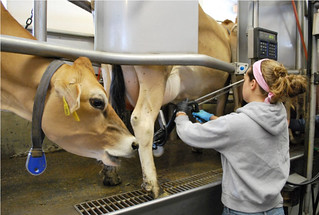 With the next generation’s commitment to continuing and enhancing the family farms, Andrew expects the Connecticut dairy industry to continue to thrive: “More young people are seeing opportunities on the farm. They stay because they want to.” A trend among the young farmers is to include the consumer in the operation by opening the farms to the public, offering tours, corn mazes and direct sales of their own value-added products like ice cream and cheese.
With the next generation’s commitment to continuing and enhancing the family farms, Andrew expects the Connecticut dairy industry to continue to thrive: “More young people are seeing opportunities on the farm. They stay because they want to.” A trend among the young farmers is to include the consumer in the operation by opening the farms to the public, offering tours, corn mazes and direct sales of their own value-added products like ice cream and cheese.
Although small by the standards of big dairy states like Wisconsin and California, UConn’s cohesive dairy program provides outstanding and comprehensive support to the dairy industry, by generating knowledge through research, by disseminating information to producers and by nurturing the next generation. And in the process, they make this fabulous ice cream …
Says Zinn, “The dairy program is a mainstay of Horsebarn Hill, from 4-H and FFA through adulthood, whether it’s watching the cows, working in the barns, eating the ice cream, studying here as an undergraduate or graduate student. We have people from 4-H through PhDs who have impacts throughout the country based on their experience here.”

